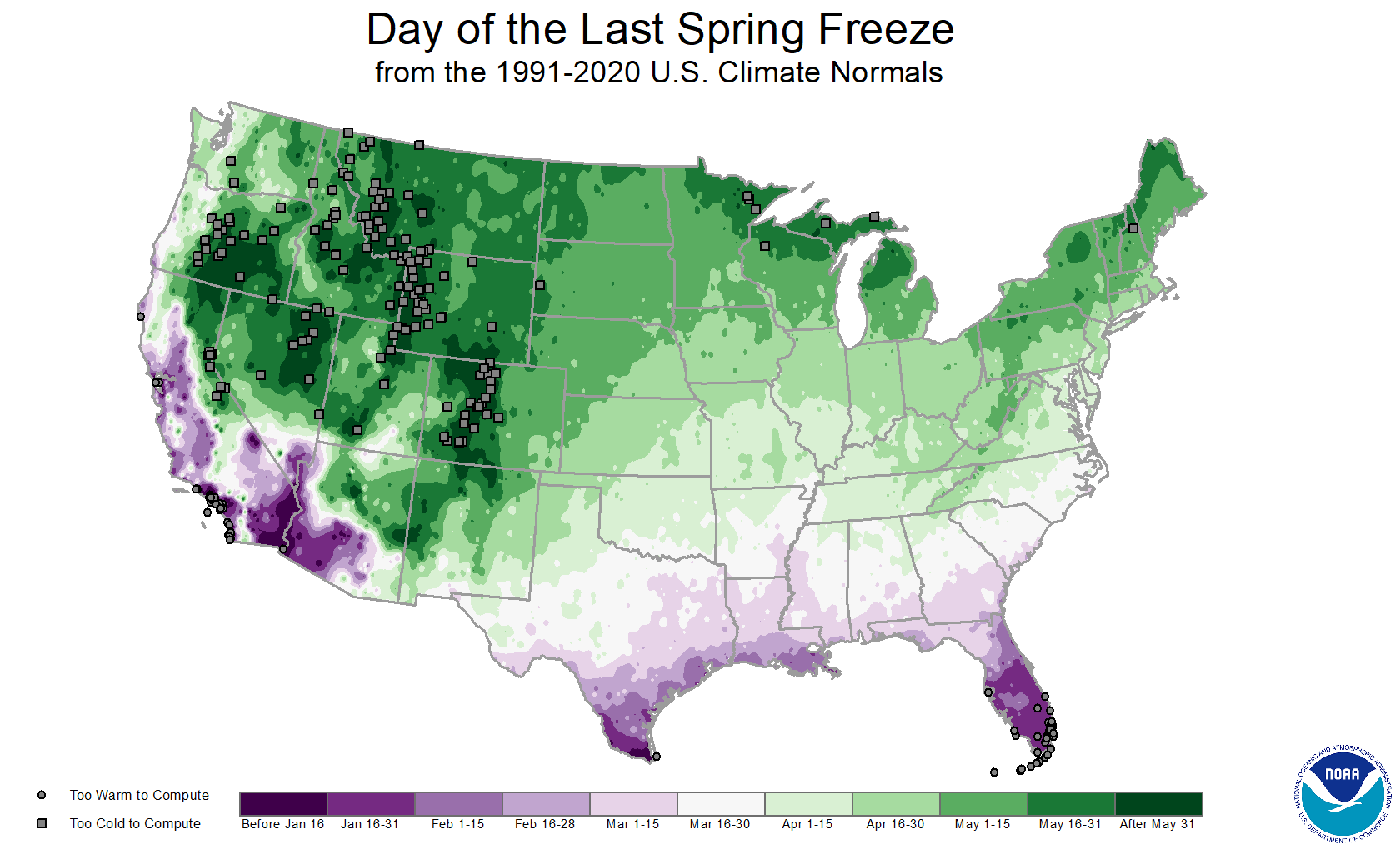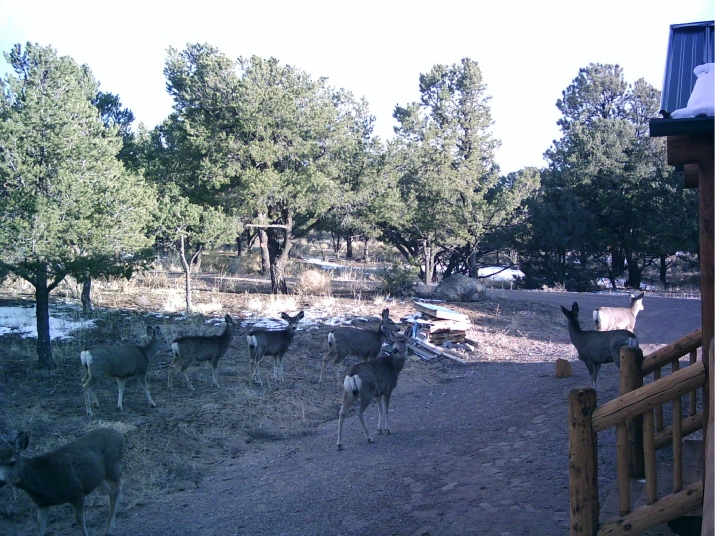Crestone
Weather Center
- Keno's Home and Crestone's Official Weather Station -
![]()
Weather Data
- First and last freeze dates for Crestone/Baca, Colorado -
When should you start up your garden this spring, or close it down in the fall? The list below should give you a clue when it's safe to do that as far as freezing temps go. But the average last freeze date is around June 1 for our area (and that is one of the latest dates for anywhere in our country). Other factors need to be consider too, like some folks wait until the deer leave, and I have listed info on their migration out of town for the summer, too. For the first freeze of fall, September 29 is now the average date for our area (as of 2025), although that date is now a full two full weeks later than it was just 10 year ago, because of out of control man-made climate change.
| Year | Latest Freeze Date | Temperature (°F) | Earliest Freeze Date | Temperature (°F) |
| 2025 | May 21 | 32° | October 5 | 30° |
| 2024 | May 26 | 30° | October 20 | 31° |
| 2023 | June 2 | 31° | October 5 | 30° |
| 2022 | May 30 | 31° | October 10 | 32° |
| 2021 | May 24 | 27° | September 21 | 31° |
| 2020 | June 9 | 29° | September 8 | 26° |
| 2019 | June 23 | 32° | October 3 | 32° |
| 2018 | May 4 | 31° | October 6 | 30° |
| 2017 | May 28 | 31° | September 26 | 28° |
| 2016 | May 28 | 31° | September 23 | 30° |
| 2015 | May 20 | 29° | October 24 | 31° |
| 2014 | June 9 | 32° | October 1 | 32° |
| 2013 | May 21 | 32° | September 22 | 31° |
| 2012 | May 27 | 32° | September 15 | 32° |
| 2011 | May 31 | 29° | October 6 | 31° |
| 2010 | May 25 | 26° | September 11 | 22° |
| 2009 | May 28 | 32° | September 21** | 32° |
| 2008 | June 13 | 29° | October 6 | 29° |
| 2007 | June 8 | 25° | September 25 | 25° |
| 2006 | June 30 | 31° | September 16 | 31° |
| 2005 | June 13 | 31° | September 15 | 26° |
| 2004 | June 29 | 30° | September 4 | 30° |
| 2003 | June 17 | 30° | September 11 | 29° |
| 2002 | May 25 | 32° | September 19 | 32° |
| 2001 | June 14 | 29° | September 9 | 28° |
| 2000 | May 20 | 32° | September 25 | 30° |
| 1999 | June 6 | 30° | September 22 | 32° |
| 1998 | June 15 | 32° | October 4 | 32° |
| 1997 | May 27 | 29° | October 8 | 30° |
| 1996 | April 30 | 28° | September 19 | 28° |
| 1995 | May 28 | 30° | September 22 | 26° |
| 1994 | May 26 | 32° | October 7 | 30° |
| 1993 | June 9 | 31° | September 14 | 31° |
| 1992 | May 11 | 30° | October 8 | 24° |
| 1991 | May 16 | 32° | September 16 | 31° |
| 1990 | May 17 | 29° | October 9 | 20° |
| 1989 | May 1 | 25° | September 14 | 32° |
| 1988 | June 1 | 30° | September 19 | 30° |
| 1987 | May 30 | 31° | September 28* | 30° |
| 1986 | May 19 | 30° | September 11 | 30° |
| 1985 | May 15 | 25° | September 23 | 29° |
| 1984 | May 11 | 31° | September 28 | 28° |
| 1983 | June 14 | 30° | September 21 | 29° |
| 1982 | May 16 | 32° | October 2 | 31° |
* Data incomplete for entire month
|
Latest last freeze date recorded during
the growing season: 31° on June 30, 2006 Earliest last freeze date recorded to start the growing season took place on April 30, 1996. Earliest first freeze date recorded during the growing season: 30° on September 4, 2004*(**) Latest first freeze date recorded to end the growing season took place on October 24, 2015. Average last freeze is around June 1, and average first freeze is around September 20, and getting later each year. Most consecutive days of not seeing freezing temperatures: 5 months and 4 days, set in 2015. All temperature records up until Sept 2006, were recorded at Hal Reinhart's old Crestone/Baca weather station (8,600 feet elevation), located 1 mile northeast of present station in Baca Chalet 1 (8,085 feet in elevation), all records afterwards come from this station. Note: The above chart is not based on the average temperatures for our area, but based on actual first and last dates that freezing occurred in each season/year. A new all time record for the latest date where the first freezing temperature of the fall season occurred, was set in 2015, on October 24. The old record date was October 9 (set in 1990). **On August 9, 2009, freezing temps and frost was reported nearby in the Baca Grants and in most of the valley (the official low at this station was 36°). This also occurred back on August 11, 2003, when the official low at the weather station was 34°. |
![]() First Freeze Date for U.S. - Map
First Freeze Date for U.S. - Map![]()

![]() Last Freeze Date for U.S. - Map
Last Freeze Date for U.S. - Map![]()

While these maps show the average timeframe of the first and last freeze across the United States, each year’s actual conditions may vary widely based on weather patterns. Wondering why no data on Alaska and Hawaii? The unique climates of these regions pose a problem in calculating the average date of the first and last freeze. Nearly all of Alaska falls into the “too cold to compute” category, meaning that the state is likely to see freezing temperatures year-round. At the opposite end of the spectrum, all of Hawaii, other than the highest elevations of the state, fall into the “too warm to compute” category, meaning that they very rarely or never see freezing temperatures.
![]() First and Last Frost Dates
First and Last Frost Dates![]()
There is a difference between the last/first Freeze date and the last/first Frost date, as we can see frost with temps above freezing (37 degrees is about the highest*). Plus all of the above maps aren't really 100% true for our area, since conditions vary depending on exactly where in the greater Crestone/Baca you live when it comes to these different events. Yet while more of us in this area live in the foothills and not in the valley, when it comes to frost (unlike snowfall), most of our foothills see the same first/last frost dates that are also seen in the SLV. For the frost map, most of our area is in area 4, other than our mountains are in area 3. Do note that they got the dates wrong for area 3, as our highest peaks above 13,000 and 14,000 feet can see frost year round, as all such peaks in the Rockies can.
*the reason for this is that we measure the temperature at a height of about 5 feet (and why it's called the "air temperature"), and at ground level it can be a few degrees colder at the very same time, since cold air sinks. This happens often in the spring and fall, so do keep that in mind, since your garden sits on the ground!
What does a "hard freeze" mean? Some plants can handle a light freeze of around 32°(F) or even a bit colder, but not a hard freeze. A hard freeze occurs when the temperature reaches 28°(F) or lower for at least a few hours. It usually means that many types of plants and most seasonal vegetation will be destroyed.
![]() Last Deer Date
Last Deer Date![]()
I received an email suggesting I also list the "last deer
date" on this page. This page was made mainly for local gardeners who each late
spring wonder just how early they might start their gardens. Of course, the many
deer we have in the greater Crestone area causes problems for local gardens. But
yes, in most of the Baca, the deer leave for the summer, keeping our gardens safe
from these hungry animals. But it depends on where you are located as to when you
will see less deer. Rule of thumb is to go by your elevation, since the deer
live higher up in the summer months. If you live below 9000 feet, they usually
leave around or just after June 1 - in most years. Over that elevation, or in
the town of Crestone, you
may see deer year-round.
The deer usually return by the end of September (below 8500 feet, mid September above), pretty much after the growing season is over, so the late spring is the time to be ready for their visits to your garden.
Crestone's Deer in Spring

April, 2003
Crestone Weather Records | Current Crestone Conditions | Links
